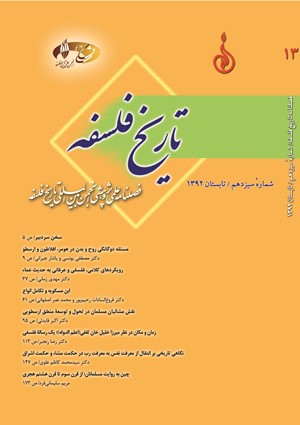رويکردهاي کلامي، فلسفي و عرفاني به حديث عماء
محورهای موضوعی : ریشهشناسی واژگان (اتیمولوژی) فلسفی
1 - دانشگاه پيام نور
کلید واژه: حديث عماء نفَس رحماني وجود منبسط خيال مطلق حقيقةالحقايق ,
چکیده مقاله :
در حديث مشهوري از پيامبراكرم(ص) نقل شده که پروردگار پيش از آفرينش خلق در «عماء» بود. سند و محتواي اين حديث مورد اظهار نظرهاي گوناگون و متعارضي قرار گرفته است و متکلمان، عارفان، حکيمان و مفسران مسلمان براساس مباني خويش به آن توجه نموده و در نظام فکري خويش از آن بهره بردهاند. متکلمان براساس ديدگاههاي تنزيهي و تشبيهي خود به تأويل حديث پرداخته و آن را مورد پذيرش يا رد قراردادهاند. برخي از عارفان مسلمان «عماء» را اشاره به مرتبه احديت و ديگران آن را حاکي از مرتبه واحديت دانستهاند. آنان عماء را با «نَفَس رحماني»، «حق مخلوق به»، «خيال مطلق» و «جوهر عالم» تطبيق نموده و براي آن جايگاهي رفيع درنظر گرفتهاند. ملاصدرا در حکمت متعاليه خويش عماء را با «وجود منبسط»، «أحديهالجمع» و «حقيقةالحقايق» تطبيق نموده و با تأويل حديث به اخذ نتايجي در باب احاطه وجود الهي بر همه مکانها و زمانها ميپردازد و تلاش ميکند تا ميان تشبيه و تنزيه جمع کند.
It has been narrated in a famous hadith from the Holy Prophet (s) that, before the creation of people, God was in “‘ama” (cloud). There have been several different and contradictory ideas concerning the content of this hadith. Muslim mutikallimun, gnostics, philosophers, and interpreters have studied this hadith based on their own principles and have benefitted from it in their own philosophical system. Mutikallimun have interpreted it based on their tanzihi (transcendent) and tashbihi (comparative) views and either confirmed or rejected it. Some Muslim gnostics assume that “‘ama” refers to God’s henas, and others believe that it represents the station of monas. They have matched this term with “merciful breath”, “truth of the creature”, “absolute imagination, and “substance of the world” and have granted it a sublime place. In his Transcendent Philosophy, Mulla Sadra equates ‘ama with “unfolded being”, “unity of bringing together” and “truth of truths” and, through the interpretation of hadith, reaches some conclusions about the dominance of divine existence over all places and times and attempts to reconcile tanzih with tashbih.


